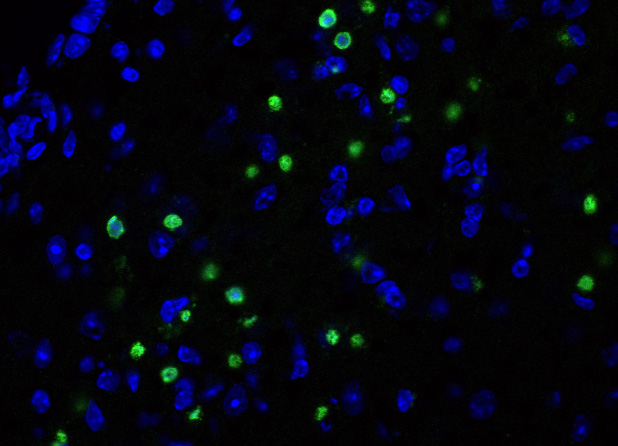

Ferroptotic neurons in the murine cortex. Nuclei are stained in blue, ferroptotic cells in green.
Source: Helmholtz Zentrum München
Age-related neurodegenerative diseases are regarded to be one of the most important medical challenges of the coming decades. In Germany alone more than 1.5 million people are living with dementia, two thirds of whom are suffering from Alzheimer’s disease.
In view of the demographic change, the prevalence of neurodegenerative diseases is continuously increasing and thus represents not only a major health problem but also a growing socio-economic burden. In addition, while a fraction of neurodegenerative diseases is less associated with age, they are still fatal, such as amyotrophic lateral sclerosis (ALS) or Huntington’s disease.
Although different regions of the brain and neurons are usually affected, the early and progressive loss of nerve cells is a common hallmark of these illnesses. The latest results prove that neuronal cell death is largely caused by regulated necrotic cell death mechanisms, including ferroptosis, a novel form of cell death marked by iron-dependent lipid peroxidation*. This important insight allows the development of substances that may prevent the death of neurons.
Liproxstatin as a neuroprotective agent
In extensive preliminary work Helmholtz researchers led by Dr. Marcus Conrad at the Helmholtz Zentrum München screened more than 40,000 new substances for their anti-ferroptotic properties. Thereby, the chemical class of spiroquinoxalines (termed liproxstatins) stood out particularly for its strong cell-protective activity, drug-like property and its proven efficacy in various animal models of degenerative disease. Subsequent lead optimisation studies resulted in the identification of substances that could efficiently cross the blood-brain barrier and are therefore considered as promising neuroprotective agents.
Meanwhile, the Conrad group has also been able to demonstrate the molecular effects of liproxstatins in the context of ferroptosis. With the VIP+ programme they now want to take the next step and validate the efficacy of these potentially neuroprotective agents in pre-clinically relevant models of neurodegenerative disease.
“Up to now, neurodegenerative conditions have been inadequately treated and, if so, mostly symptomatically,” explains Dr. Marcus Conrad, group leader at the Institute for Developmental Genetics (IDG). “Ferroptosis inhibitors could, for the first time, lead to the development of a new and effective therapeutic approach to prevent the progressive loss of nerve cells at an early stage,” adds IDG scientist Dr. Bettina Proneth.
Accordingly, Conrad and his team hope that within the framework of the VIP+ programme a key milestone will be reached that will constitute not only the basis for further pre-clinical development on the road to medical approval and application, but will also spark great interest among pharma industry and venture capitalists for further (pre) clinical development.
Further Information
Background:
The term ferroptosis was coined in 2012. It is derived from the Greek word ptosis, meaning “a fall”, and ferrum, the Latin word for iron, and describes a form of regulated cell death in which iron plays an important role. “The individual mechanisms involved in this type of cell death emerge only slowly, and our team has already delivered some groundbreaking work that is contributing towards a better understanding of ferroptosis,” says Dr. Marcus Conrad, who heads the working group at the IDG.
The Helmholtz Zentrum München, the German Research Center for Environmental Health, pursues the goal of developing personalized medical approaches for the prevention and therapy of major common diseases such as diabetes and lung diseases. To achieve this, it investigates the interaction of genetics, environmental factors and lifestyle. The Helmholtz Zentrum München is headquartered in Neuherberg in the north of Munich and has about 2,300 staff members. It is a member of the Helmholtz Association, a community of 18 scientific-technical and medical-biological research centers with a total of about 37,000 staff members. http://www.helmholtz-muenchen.de/en
Rising life expectancy is causing an increase in age-related, but also sociological and environmental, influences on the genes. The Institute of Developmental Genetics (IDG) examines these changes in genetic material. In the Mouse Genetics group, genetic animal models are developed to investigate various diseases. These models are analyzed in the Disease Modelling research group in order to identify gene functions and cell processes and evaluate the influence of the environment and aging processes. The group focuses on the examination of neurological and psychiatric diseases. http://www.helmholtz-muenchen.de/idg
Contact for the media:
Department of Communication, Helmholtz Zentrum München – German Research Center for Environmental Health, Ingolstädter Landstr. 1, 85764 Neuherberg – Tel. +49 89 3187 2238 – Fax: +49 89 3187 3324 – E-mail: presse@helmholtz-muenchen.de
Scientific Contact at Helmholtz Zentrum München:
Dr. Marcus Conrad, Helmholtz Zentrum München – German Research Center for Environmental Health, Institute of Developmental Genetics, Ingolstädter Landstr. 1, 85764 Neuherberg – Tel. +49 89 3187 4608, E-mail: marcus.conrad@helmholtz-muenchen.de















